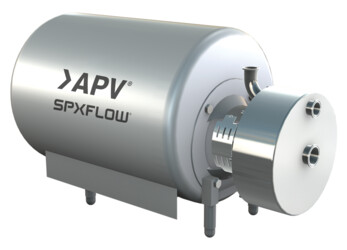STORIES IN THE MAKING

A Smarter, Steam-Free Solution: How Cavitation Is Transforming Spray Dryer Feed Heating and Centrifugal Atomizer Performance
When it comes to spray drying, preheating the concentrate before atomization is essential. But traditional steam-based systems bring persistent problems—scaling, inconsistent product quality, inflexibility and high energy costs.
There’s now a smarter, more efficient way forward.
Why Traditional Heating Holds You Back
Most spray dryers use tubular or plate heat exchangers powered by steam. These systems are widespread—but far from ideal.
Key challenges include:
- Fouling and scaling that reduce runtime and increase maintenance
- Product degradation from long residence times and uneven heating
- Limited capacity flexibility due to viscosity constraints at higher dry solids
- High operating costs driven by fossil-fuel steam generation
If you’re aiming to increase dryer output, reduce energy use or improve product consistency, these limitations get in the way.
Meet the APV® Cavitator: A Steam-Free Breakthrough
The APV Cavitator uses controlled hydrodynamic cavitation to heat liquids mechanically—without the need for hot surfaces or steam. Installed directly above the spray dryer near the centrifugal atomizer, it significantly shortens the time between heating and atomization. The result? Better atomization, reduced viscosity and preserved product quality.
What Sets the Cavitator Apart
- No scaling – Extended runtime with less cleaning and downtime
- Plug-and-play design – Simple integration into existing systems
- Electric-powered – No reliance on natural gas or steam
- Instant, uniform heating – Gentle on concentrate, no risk of degradation
- Boosts dryer output – 8°C heating can increase capacity by 1.5–3%
- Cuts energy use per ton – Enables higher solids at the inlet for lower drying costs
Move Toward More Output—and Away from Downtime
The cavitator helps you move toward higher throughput, lower energy costs and better process control—while moving away from scaling, inefficiencies and product risk.
Benefits at a Glance
- Allows for higher feed solids at the inlet, resulting in:
- Up to 3% increase in drying capacity
- Lower energy cost per ton of powder
- Reduces fouling and cleaning requirements
- Maintains final product quality with no compromise
Built for Modern Spray Drying
For producers using rotary atomizers, the APV Cavitator is a practical upgrade that delivers measurable results. It’s designed to adapt to your plant—not the other way around.
Ready to improve your spray dryer performance?
Connect with one of our solution makers to explore how the cavitator fits your process.
